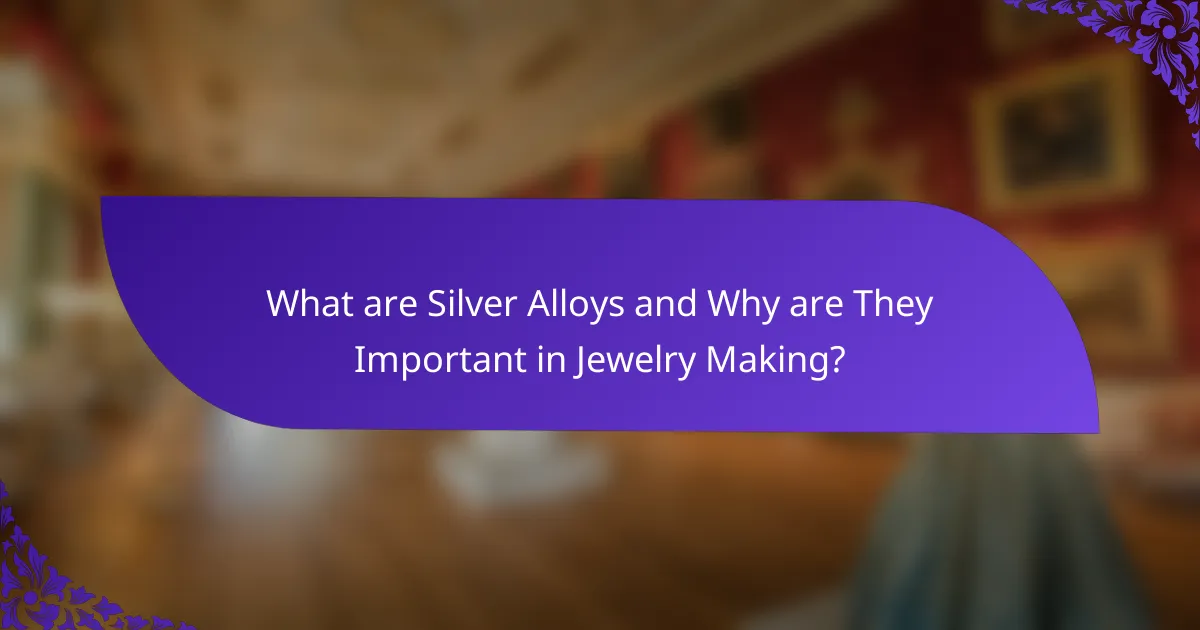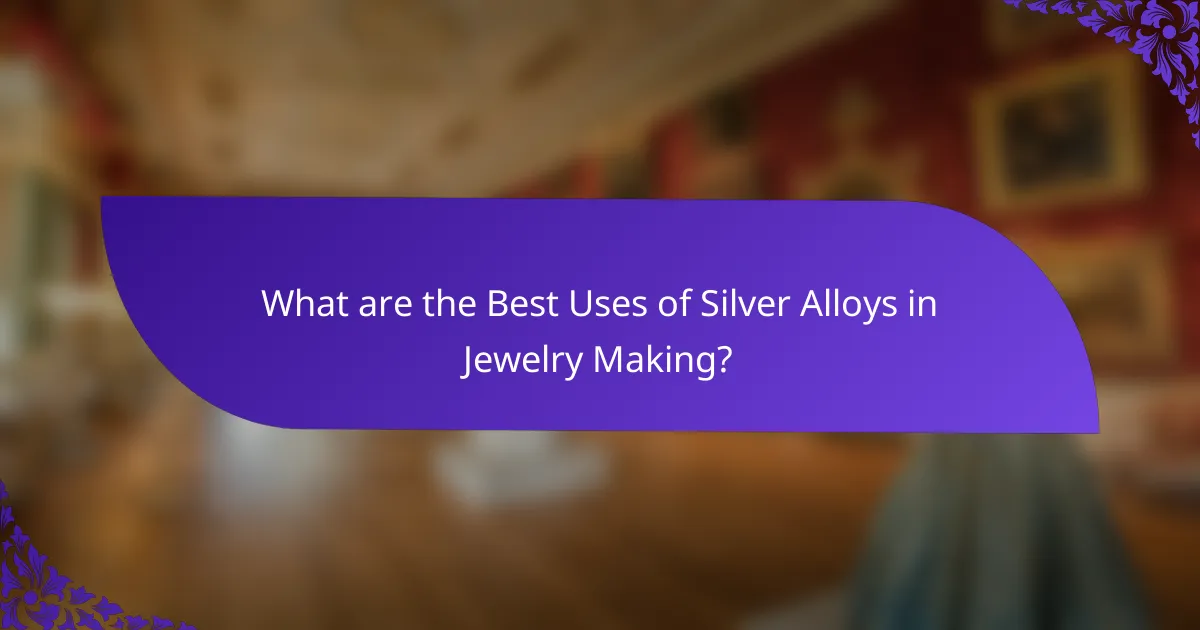Silver alloys are mixtures of silver with other metals, such as copper, nickel, and zinc, designed to enhance properties like strength, durability, and tarnish resistance. A prominent example is sterling silver, which consists of 92.5% silver and 7.5% other metals, making it ideal for intricate jewelry designs. The article explores the various types of silver alloys, their properties, and their applications in jewelry making, highlighting the benefits of alloys like Argentium silver for everyday wear and the versatility of silver-filled wire and solder for crafting. Overall, understanding silver alloys is essential for creating durable and aesthetically appealing jewelry pieces.

What are Silver Alloys and Why are They Important in Jewelry Making?
Silver alloys are mixtures of silver with other metals to enhance their properties. Common metals used include copper, nickel, and zinc. These alloys improve strength, durability, and resistance to tarnishing. For instance, sterling silver consists of 92.5% silver and 7.5% other metals. This composition makes it suitable for intricate designs and everyday wear. The use of silver alloys is crucial in jewelry making for achieving desired aesthetics and functionality. They allow jewelers to create items that are both beautiful and long-lasting.
How are Silver Alloys Different from Pure Silver?
Silver alloys contain other metals mixed with silver, while pure silver is made up of 99.9% silver. The presence of these additional metals, such as copper, enhances the strength and durability of the alloy. Pure silver is softer and more malleable than silver alloys. This softness makes pure silver less suitable for everyday jewelry items that require durability. Silver alloys, like sterling silver, typically consist of 92.5% silver and 7.5% other metals. This composition balances beauty and practicality for jewelry making. The addition of metals in alloys also affects the color and tarnishing properties of the silver.
What are the key characteristics of pure silver?
Pure silver, also known as fine silver, is characterized by its high purity level of 99.9% silver content. This high purity gives pure silver a bright, shiny appearance. Pure silver is highly malleable, allowing it to be easily shaped and formed into various designs. It is also ductile, meaning it can be drawn into thin wires without breaking.
In terms of conductivity, pure silver has the highest electrical and thermal conductivity of all metals. However, pure silver is relatively soft compared to other metals, making it susceptible to scratches and dents. Pure silver does not tarnish as quickly as sterling silver but can still develop a patina over time when exposed to air and moisture.
Due to its high purity, pure silver is often used in applications where conductivity is critical, such as in electronics. Its aesthetic qualities make it popular in jewelry making, although it is typically alloyed with other metals for added durability.
What modifications do alloys introduce to silver’s properties?
Alloys modify silver’s properties by altering its hardness, strength, and tarnish resistance. For instance, adding copper to silver increases its hardness, making it more suitable for jewelry. This combination, known as sterling silver, typically contains 92.5% silver and 7.5% copper. The increased copper content enhances durability while maintaining a bright appearance. Additionally, alloys can improve tarnish resistance, depending on the metals used. For example, adding nickel or zinc can further enhance corrosion resistance. These modifications make silver alloys more practical for everyday wear in jewelry.
What Types of Silver Alloys are Commonly Used in Jewelry?
Sterling silver and Argentium silver are commonly used silver alloys in jewelry. Sterling silver consists of 92.5% silver and 7.5% other metals, usually copper. This alloy is known for its durability and bright appearance. Argentium silver is a modern alloy that contains a minimum of 92.5% silver and includes germanium. This addition enhances tarnish resistance and gives it a brighter finish. Other silver alloys include coin silver, which typically contains 90% silver, and Britannia silver, which has 95.8% silver content. Each type of alloy has unique properties that make them suitable for various jewelry applications.
What is Sterling Silver and what are its attributes?
Sterling silver is a metal alloy consisting of 92.5% silver and 7.5% other metals, typically copper. This composition gives sterling silver its strength and durability while maintaining the desirable properties of silver. The high silver content ensures that it retains the luster and beauty of pure silver. Sterling silver is commonly used in jewelry making due to its excellent workability and resistance to tarnish. It can be polished to a high shine, making it appealing for various designs. Additionally, sterling silver is hypoallergenic for most people, making it suitable for sensitive skin. The alloy’s properties make it a popular choice for both fine and everyday jewelry.
What are Argentium and its unique properties?
Argentium is a type of silver alloy that contains a higher percentage of silver compared to traditional sterling silver. It typically consists of 93.5% silver and 6.5% copper. This unique composition gives Argentium several distinctive properties. Argentium is known for its superior tarnish resistance due to the presence of germanium. This property allows pieces made from Argentium to maintain their shine longer than standard sterling silver. Additionally, Argentium has a bright, white finish that enhances its aesthetic appeal. It is also more malleable and ductile than traditional silver, making it easier to work with in jewelry making. These attributes make Argentium a popular choice among jewelers seeking both beauty and durability in their creations.
How does Coin Silver differ from other silver alloys?
Coin silver is an alloy primarily composed of 90% silver and 10% copper. This specific composition distinguishes it from other silver alloys, which may contain varying percentages of silver. For example, sterling silver contains 92.5% silver and 7.5% other metals. Coin silver was historically used for minting coins, hence its name, while sterling silver is more common in jewelry making. Additionally, coin silver may exhibit a slightly different color and workability due to its copper content. The historical context of coin silver usage dates back to the 19th century in the United States, where it was prevalent before the adoption of sterling silver standards.

What Properties Do Silver Alloys Possess?
Silver alloys possess properties such as enhanced strength, improved durability, and resistance to tarnishing. These properties arise from the combination of silver with other metals like copper or zinc. For example, sterling silver, which is 92.5% silver and 7.5% copper, exhibits greater hardness than pure silver. This increased hardness makes silver alloys suitable for various applications, including jewelry. Additionally, silver alloys can be polished to achieve a bright luster, enhancing their aesthetic appeal. Their resistance to oxidation further contributes to their longevity in jewelry pieces. Overall, the properties of silver alloys make them versatile and desirable for crafting durable and attractive jewelry.
How does the composition of silver alloys affect their durability?
The composition of silver alloys significantly affects their durability. Higher silver content generally leads to increased malleability but can reduce hardness. Alloys with metals like copper enhance strength and wear resistance. For example, sterling silver, consisting of 92.5% silver and 7.5% copper, offers a balance of beauty and durability. The presence of other metals can also influence corrosion resistance. Alloys with added nickel or zinc can improve tarnish resistance and overall longevity. Thus, the specific metals and their ratios in silver alloys directly impact their performance in various applications, particularly in jewelry making.
What role do other metals play in enhancing strength?
Other metals enhance strength in silver alloys by providing increased hardness and durability. For instance, copper is commonly added to sterling silver to improve its tensile strength. This combination allows for the creation of jewelry that withstands wear and tear. Additionally, metals like zinc and nickel can also be included to enhance corrosion resistance. The presence of these metals helps maintain the structural integrity of the alloy over time. Research shows that the right metal combinations can significantly improve the mechanical properties of silver alloys.
How does alloy composition influence tarnishing?
Alloy composition significantly influences tarnishing in silver alloys. The presence of metals like copper in silver alloys increases susceptibility to tarnishing. Copper reacts with sulfur compounds in the air, leading to tarnish formation. Alloys with higher silver content generally tarnish less than those with more base metals. For example, sterling silver, which contains 92.5% silver, tarnishes slower compared to lower silver content alloys. Additionally, the presence of protective coatings can reduce tarnishing, regardless of alloy composition. Thus, the specific blend of metals in an alloy directly affects its tarnishing rate and appearance over time.
What are the aesthetic qualities of silver alloys?
Silver alloys possess a bright, lustrous appearance that is visually appealing. Their reflective qualities enhance the brilliance of jewelry. The alloying process can modify the color, often resulting in a warmer tone compared to pure silver. Common alloys, like sterling silver, have a slightly darker hue due to the presence of copper. This color variation can add depth and character to designs. Additionally, silver alloys can be polished to achieve a high shine or left with a matte finish for a more subdued look. The versatility in texture and color makes silver alloys suitable for various aesthetic preferences in jewelry making.
How does the finish of silver alloys impact their appearance?
The finish of silver alloys significantly impacts their appearance. Different finishes can enhance or diminish the visual qualities of the alloy. For instance, a polished finish creates a bright, reflective surface that highlights the alloy’s luster. Conversely, a matte finish offers a softer, subdued look, reducing glare and emphasizing texture. Additionally, finishes like antiquing can add depth and character by highlighting the details in the design. The choice of finish can also influence the perceived color of the alloy. For example, a brushed finish may give a warmer tone compared to a highly polished surface. Overall, the finish plays a crucial role in defining the aesthetic appeal of silver alloys in jewelry.
What color variations can be found in different silver alloys?
Silver alloys can exhibit various color variations based on their composition. Common silver alloys include sterling silver, which typically has a bright, shiny appearance. Argentium silver features a whiter tone due to the addition of germanium. Coin silver, often used in older pieces, has a slightly warmer hue. Other alloys may contain copper, which can impart a reddish tint. The presence of different metals like gold or palladium can also alter the color, leading to shades of yellow or rose. These variations are important in jewelry making as they affect aesthetics and market value.

What are the Best Uses of Silver Alloys in Jewelry Making?
Silver alloys are commonly used in jewelry making for their durability and aesthetic appeal. Sterling silver, an alloy of 92.5% silver and 7.5% other metals, is popular for crafting rings, necklaces, and bracelets. The added metals enhance strength while maintaining a bright finish. Argentium silver, containing a higher percentage of germanium, is known for its tarnish resistance. This makes it ideal for everyday wear jewelry.
Other uses include silver-filled wire for intricate designs and silver solder for joining pieces. These alloys allow for a range of finishes, from polished to matte. The versatility of silver alloys supports various styles, from traditional to contemporary.
What types of jewelry are most commonly made from silver alloys?
Common types of jewelry made from silver alloys include rings, bracelets, necklaces, and earrings. These pieces often utilize sterling silver, which consists of 92.5% silver and 7.5% other metals, typically copper. Sterling silver is favored for its durability and luster. Additionally, argentium silver, which contains a higher percentage of germanium, is used for its tarnish-resistant properties. Other jewelry items include pendants, brooches, and charms. Silver alloys are popular in both fashion and fine jewelry due to their versatility and aesthetic appeal.
How do silver alloys contribute to the design of rings and bracelets?
Silver alloys enhance the design of rings and bracelets by improving strength and durability. Pure silver is too soft for everyday wear. Alloys, such as sterling silver, typically contain 92.5% silver and 7.5% other metals like copper. This combination increases hardness while retaining a bright appearance. The alloying process allows for intricate designs that would otherwise be impractical with pure silver. Additionally, silver alloys can be polished to a high shine, enhancing aesthetic appeal. Their resistance to tarnishing also contributes to the longevity of jewelry pieces. Overall, silver alloys significantly influence both the functionality and beauty of rings and bracelets.
What advantages do silver alloys offer for intricate designs?
Silver alloys provide enhanced strength and ductility for intricate designs. They allow for detailed craftsmanship without compromising durability. The addition of metals like copper increases hardness while maintaining malleability. This combination enables jewelers to create complex shapes and fine details. Silver alloys also have a lower melting point than pure silver, facilitating easier casting and molding. Additionally, they exhibit excellent corrosion resistance, ensuring longevity in intricate pieces. The aesthetic appeal of silver alloys, with their bright luster, enhances the visual quality of detailed designs. These properties make silver alloys a preferred choice for intricate jewelry applications.
What considerations should be made when choosing silver alloys for jewelry?
When choosing silver alloys for jewelry, consider the alloy’s purity, durability, and aesthetic appeal. Purity affects the alloy’s quality and value. Common silver alloys include sterling silver, which contains 92.5% silver and is durable for everyday wear. Durability is essential for pieces subject to frequent use, as stronger alloys resist scratches and tarnishing. Aesthetic appeal relates to the alloy’s color and finish, impacting the overall look of the jewelry. Additionally, consider hypoallergenic properties for sensitive skin. The alloy’s melting point is also significant for crafting techniques. Each of these factors contributes to the suitability of the alloy for specific jewelry applications.
How do cost and quality compare among different silver alloys?
Cost and quality vary significantly among different silver alloys. Higher silver content typically results in higher costs. For instance, sterling silver (92.5% silver) is more expensive than coin silver (90% silver). The quality of silver alloys also depends on their purity and the metals used in the alloy. Alloys with higher purity generally exhibit better luster and durability. For example, argentium silver, which contains germanium, offers enhanced tarnish resistance compared to traditional sterling silver. Additionally, the cost of production influences the final price, with more complex alloys often being pricier. Overall, consumers should consider both the silver content and the properties of the alloy when evaluating cost and quality.
What maintenance practices help preserve the beauty of silver alloy jewelry?
Regular cleaning is essential to preserve the beauty of silver alloy jewelry. Use a soft cloth to gently wipe the surface after each wear. This removes oils and dirt that can cause tarnishing. Store silver alloy jewelry in a cool, dry place. A fabric pouch or anti-tarnish cloth can help prevent exposure to air. Avoid wearing jewelry while swimming or exercising. Chemicals in water and sweat can damage the alloy. Additionally, limit exposure to perfumes and lotions. These products can create a film that dulls the shine. Periodically, a professional polishing can restore luster. Following these practices can significantly extend the life and beauty of silver alloy jewelry.
What are the best practices for working with silver alloys in jewelry making?
The best practices for working with silver alloys in jewelry making include proper alloy selection, controlled heating, and effective polishing techniques. Selecting the right alloy is crucial as different silver alloys, like sterling silver, have varying properties. Controlled heating prevents overheating, which can lead to oxidation and loss of quality. Using a soldering method appropriate for the specific alloy ensures strong joints. Additionally, polishing with appropriate compounds enhances the final appearance without damaging the surface. Lastly, proper storage in anti-tarnish materials can preserve the alloy’s luster and integrity over time.
Silver alloys, primarily composed of silver mixed with other metals, are essential in jewelry making due to their enhanced properties such as strength, durability, and tarnish resistance. This article explores the various types of silver alloys, including sterling silver and Argentium silver, and their unique characteristics that make them suitable for different jewelry applications. Key considerations for selecting silver alloys, their aesthetic qualities, and best practices for maintenance and crafting are also discussed, providing a comprehensive understanding of how these alloys contribute to the beauty and functionality of jewelry.


